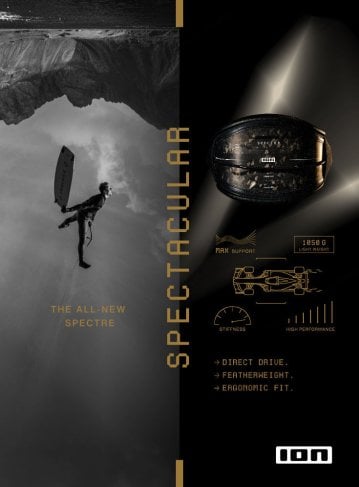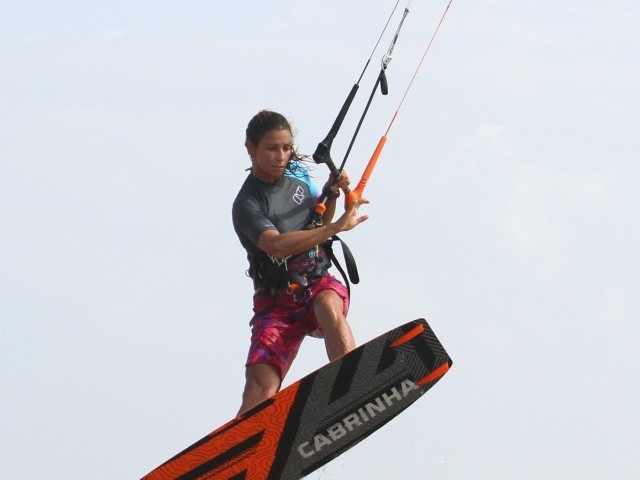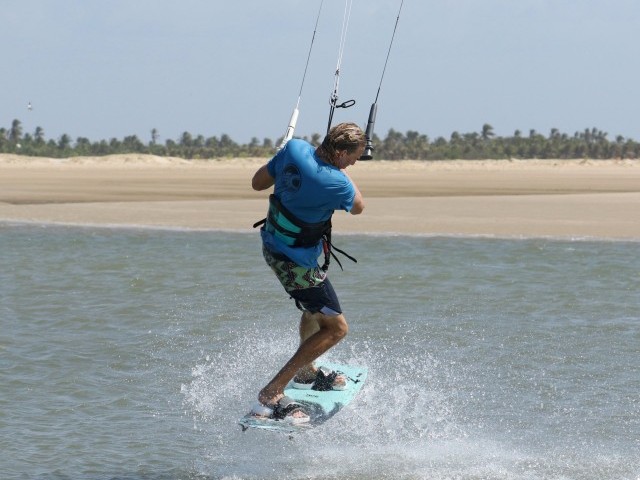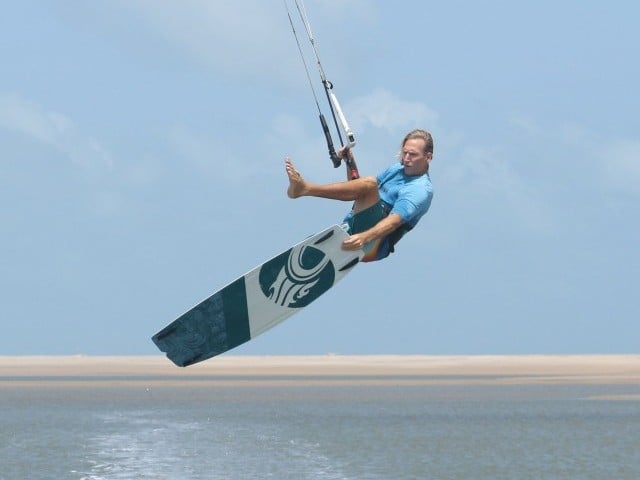
Air Gybe Nose Grab
Technique / Intermediate
Introduction
Another splendid way to make the essential art of turning around both exciting and aesthetically pleasing. There must surely be enough transition variations to keep you busy during a reasonable session, ensuring that you never need to pull off the same move twice. Now that’s something we can all appreciate. Before adding this feather to your bow, we should perhaps note that the board’s nose relates to the direction in which you’ll be landing, and the hand you’ll grab with will be your back hand, again for the direction you’ll come out of this move. For example, if you can happily whip out a nose grab jumping to the left, then trying this transition will be simpler taking off to the right, as the mechanics will be similar. Now let’s have a look at what you need to do.
The Approach Pic A.
It all starts and potentially ends here, so getting your approach right is essential. This is a transition; you’ll be changing direction. Thus, you don’t want to carry too much forward momentum into the move as it’ll make landing the other way troublesome. Control your speed by edging harder, and if need be, letting the bar out a tad, but don’t carve and don’t drift the kite up. You still need some height and hang time, so the kite needs to be around the magical 11 or 1 o’clock so that you send it. In the picture, Karine is edging hard with plenty of board in the water. She’s given her kite an aggressive send so that she’ll get good lift and early lift. This is the second consideration. If you move your kite too slowly, and from too high, you won’t get lift until the kite has gone way past 12 o’clock, which again won’t help your chances of sailing away as the kite will end up too far on the other side of the window.
The Take Off Pic B.
The take-off follows directly on from what you’ve just read. That’s to say that you need to be going up when the kite’s pretty much at 12, not when it’s way past. As you most likely know, we call this going early, you’re anticipating the lift and kicking against your edge to give the kite a wee helping hand. If you were to soften your back leg, the kite would move further back, and the move will be harder. As well as kicking off you can see that Karine is levelling her bar. Again the purpose of this is to stop the kite in its tracks; you’ve got the lift, you want the kite above you, so why allow it to go any further!
Making Space Pic C.
Those of you who can nose grab during a jump will know that part of the movement is getting the bar out of your way by sending the kite. Here as you’re transitioning and heading back the other way, this isn’t an option. Instead, you need to move yourself to create room for the grab. Do this by twisting, starting with the board and moving on up. Best bet is to look at Karine. As soon as she’s taken off, she scissors her feet and twists her hips, almost as if she were going to toe side! What this does is bring what will be the nose around underneath the bar and positions it way off to the side. This will give you plenty of space to work in:) Oh yes, and it’s worth noting that Karine keeps the bar level, to make sure that the kite is set above her, for float and time.
Time to Commit Pic D.
With the kite stable above you and the bar out of the way, the time has come to go for the grab. With what will be her new front hand centred on the bar Karine has three things to do to reach the grab, and so will you. It’s important to get your back/lower leg extended. This combines with bringing your front knee up and across, your second task. This movement pushes the nose of the board up towards you. Now releasing your new back hand helps you to drop that shoulder as you reach down towards the nose. If you don’t reach, twist and lift the knee, or extend your back leg you’ll be lucky to tickle the nose, let alone get a good grip on it.
The Grab Pic E.
There is no denying that the nose grab is a beauty! It lends itself perfectly to a tweak due to the straight back leg, so go on, style this puppy out. Once you’ve got the grab, you can pull the nose towards you while you push you back foot away as far as you can. If your board has a pretty bottom this is the photo opportunity that you don’t want to miss.
The Dive Pic F.
Chances are that while you’ve been busying yourself with that extra tweak, your kite has decided to drift across the window a tad further than you’d deem acceptable. Fear not there is a solution. However, with the kite likely at 11 or 1, depending on which way you’re going, it will need one mighty dive to pull you out of the move and set you down for a marshmallow landing. You can see that Karine has released her grab and is using both hands to steer the kite in a classic push-pull combo. This way she can keep the bar on the sweet spot while getting the kite to move as quickly as possible. Imagine that you’re trying to dive the kite straight down at the water. If you do and then point the board downwind, a smooth and claimable nose grab air gybe is yours for the taking.
Top Tips
A short, sharp send is your friend. The quicker your kite moves, the sooner it generates lift and the more chance you have of going up before the kite passes 12 o’clock - don’t be shy.
Visualise your grab movement. You’re not reaching down towards where the nose should be, but rather twisting the board across you so that it comes towards your hand. If you snowboard imagine that you’re sitting on your derriere and you want to turn onto your front so that you can push yourself up. It’s the same ungainly twisting of the board.
Have a good look at the sequence and videos to prepare yourself for the water….
Common problems
If you get the feeling that you’re being pulled away from your grab. This is the kite drifting across the window as you concentrate on the prize. Make sure you go early and stop the kite at 12 o’clock by levelling the bar.
Dropping into the water on your edge rather than landing smoothly flat downwind. Either the kite has moved too far back, in which case revert to the first problem, or you’re not giving it all the beans on the dive. Straight down and you’ll have power.
Keystones
- Slow down
- Short, sharp send
- Pop and level
- Scissor, twist, knee up and reach down
- Hefty mother of a dive
This technique article was in Issue 63 of IKSURFMAG.
Related
By Christian and Karine
Christian and Karine have been working together as a coaching team, running improver to advanced kitesurfing clinics since 2003.



























